Andrea Mantegna (Isola di Carturo, 1431 - Mantua, 1506) was one of the greatest Renaissance artists of northern Italy. The painter worked at length between Mantua, Padua, and Ferrara, and thanks to his originality and passion for classical art he managed to obtain the title of “knight.” The artistic training he received at Squarcione ’s workshop enabled him to acquire an important antiquarian culture that was the basis of many of his masterpieces.
In Padua, in the Cappella degli Scrovegni, he had the opportunity to see Giotto’s frescoes, but Paolo Uccello and Filippo Lippi had also worked in the city: ultimately, the humanistic environment in Padua was very stimulating for Mantegna. The painter’s works are known for his experiments with perspective and spatial illusionism. Andrea Mantegna influenced the great painters of the time such as Albrecht Durer, Giovanni Bellini, and Leonardo da Vinci. An artist who was free to express his art at the Gonzaga court, when he arrived in the Vatican, far from his homeland, he stayed only two years in Rome and then returned to his beloved Mantua.
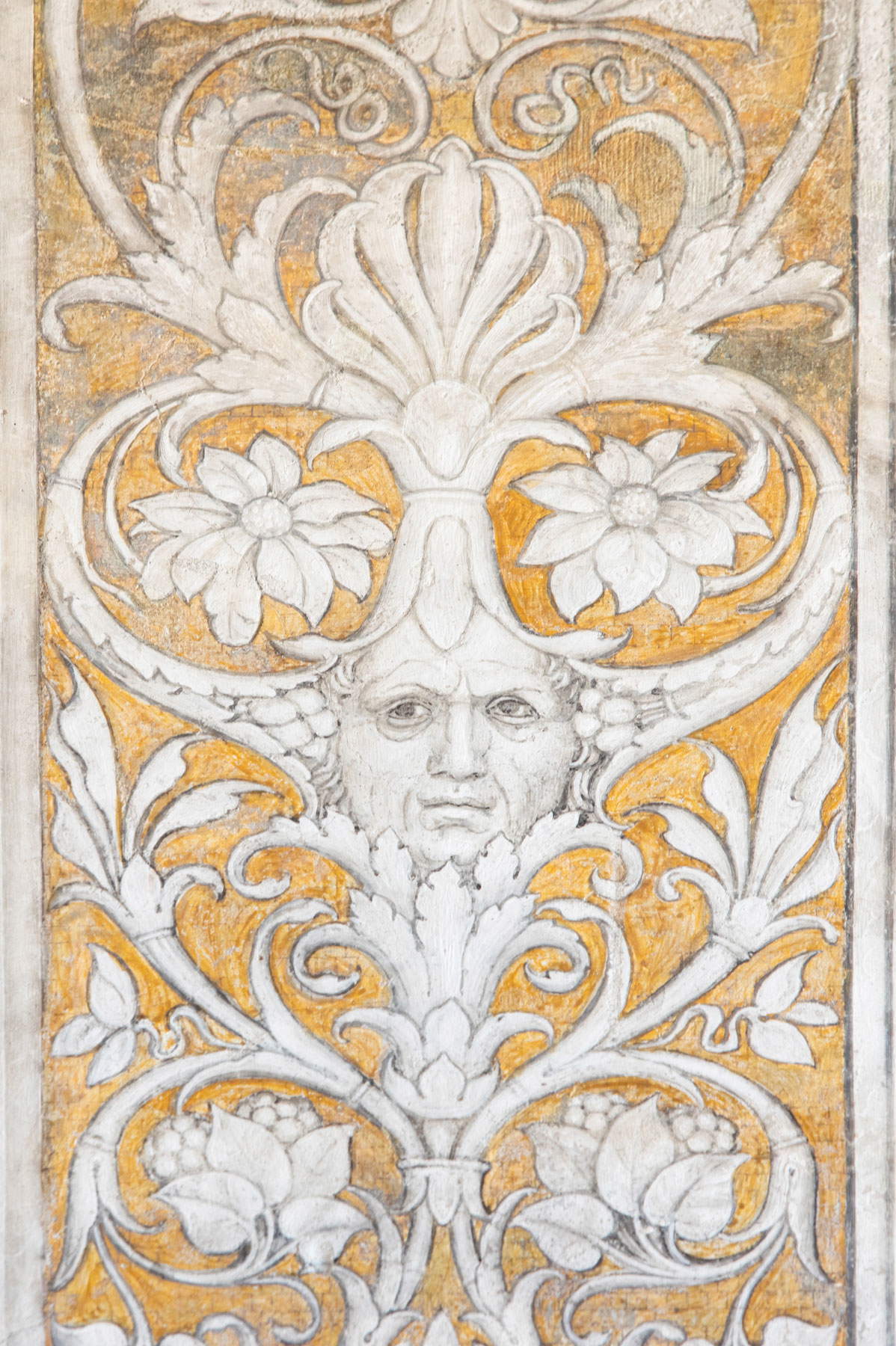 |
| Self-portrait of Mantegna in the Bridal Chamber in Mantua. Ph. Credit Alessandro Pasquali - Danae Project |
Andrea Mantegna was born in 1431 in Isola di Carturo, a village near Padua, to the carpenter Biagio. The oldest biography on the artist is due to the painter Giorgio Vasari, author of the famous collection of biographical works of artists Le vite de’ più eccellenti Architetti, Pittori, e Scultori Italiani, da Cimabue insino a’ tempi nostri (first published 1550). From Vasari we know that the painter was “of very humble stock” and that as a young man Andrea was a shepherd. At the age of ten he became an apprentice in the workshop of the painter Francesco Squarcione, who later adopted the Paduan painter. In the master’s workshop, the young Mantegna learned perspective construction, the composition of characters and objects, human anatomy, and much more. Master Francesco’s teaching method, according also to some frequent visitors and documents that have come down to us, was based on copying ancient fragments, statues and drawings from the Tuscan and Roman areas, which were part of the master’s collection, who in addition to training young painters, also sold works of art and archaeological finds.
Mantegna did not stop only at the exercise of painting, but also had a classical education, which he was able to receive thanks to the fertile humanistic climate in Padua. During these formative years he enriched his knowledge through direct observation of classical works: the works of Donatello(St. Francis, bronze statue in the Basilica of St. Anthony in Padua). The classical taste he matured during these years was fundamental in developing an original artistic language that enabled him to become a master. After spending six years in Squarcione’s workshop, the young Mantegna, in 1448, decided to break away from the master, with whom, among other things, he also had a dispute concerning monetary compensation for works executed on his behalf. From 1488 he devoted himself to a first independent work, an altarpiece for the high altar of the church of Santa Sofia in Padua: the work, however, was destroyed in the 17th century. A 1448 contract testifies to Mantegna’s first public work for the decoration of the Ovetari family chapel in the Church of the Eremitani in Padua, which was partly destroyed on March 11, 1944, during a bombing raid during World War II. Here, Mantegna found himself reunited with a group of disparate artists to decorate the chapel, and already in these early works it is possible to recognize a sensitivity toward antiquarian research.
The first trip to Ferrara can be dated to 1449: in the city, the artist had the opportunity to work for Marquis Leonello d’Este, for whom he made some portraits. The Ferrara experience was important because in the city Mantegna was able to see the paintings of Piero della Francesca and the Flemish painters that the marquis collected. Mantegna after working for Leonello was also in the service of Borso d’Este for whom he produced anAdoration of the Shepherds (1450-51). In 1453 Andrea Mantegna married Nicolosia Bellini, sister of the famous Venetian painter Giovanni Bellini. Ludovico III Gonzaga, marquis of Mantua, then invited the Paduan painter to move to the city as court painter. In the marquis’ plans was the intent to renew the city, which was deeply marked by such important artists as Leon Battista Alberti. The period at the Gonzaga court was a happy one for the painter, who in fact moved there with his entire family after the marquis granted him land on which to build a house and a fixed salary, which was no small thing for artists. During his Mantuan years, the painter cultivated a friendship with his brother-in-law Giovanni Bellini, and the two influenced each other: in addition, the artist produced numerous portraits, including those dedicated to Cardinal Ludovico Trevisan and the portrait of Francesco Gonzaga. During these years the artist also made The Death of the Virgin, and frescoed the Bridal Chamber, his great masterpiece, which he finished in 1474.
In 1484 Federico I Gonzaga granted Andrea Mantegna the title of knight, and also under the rule of Federico I Gonzaga the painter worked on the famous Cristo Morto, now preserved at the Pinacoteca di Brera (although the dating is uncertain), and the San Sebastiano that can be seen at the Louvre Museum. The ambitious project of the Triumphs of Caesar , on the other hand, was realized between about 1485-1505 during the marquisate of Francesco II Gonzaga.
Mantegna was a much sought-after and admired painter, and this was confirmed both by the esteem of Lorenzo the Magnificent, lord of Florence, to whom Mantegna sent a painting, and by an invitation in 1487 from Pope Innocent VIII, who wrote to Francesco Gonzaga to beg him to send him the now much sought-after Mantegna: the pope intended to commission the painter to decorate the chapel of the new Belvedere building in the Vatican. Mantegna stayed in the “eternal city” for only two years, from 1489 to 1490. In the late fifteenth century he produced other important works such as La madonna della Vittoria (1496) and the Pala Trivulzio (1497). The artist also waited for the decoration of Isabella d’Este’s Studiolo, which, however, Mantegna did not finish due to his death on September 13, 1506.
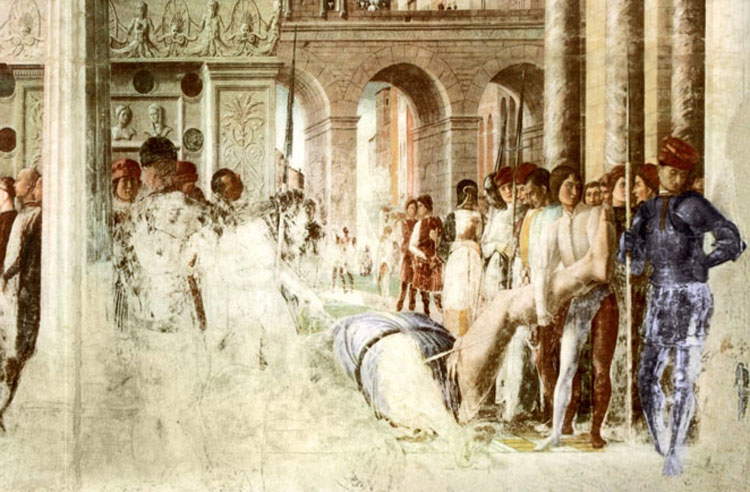 |
| Mantegna, Transporting the Body of St. Christopher, detail (1454-1457; fresco; Padua, Church of the Eremitani, Ovetari Chapel) |
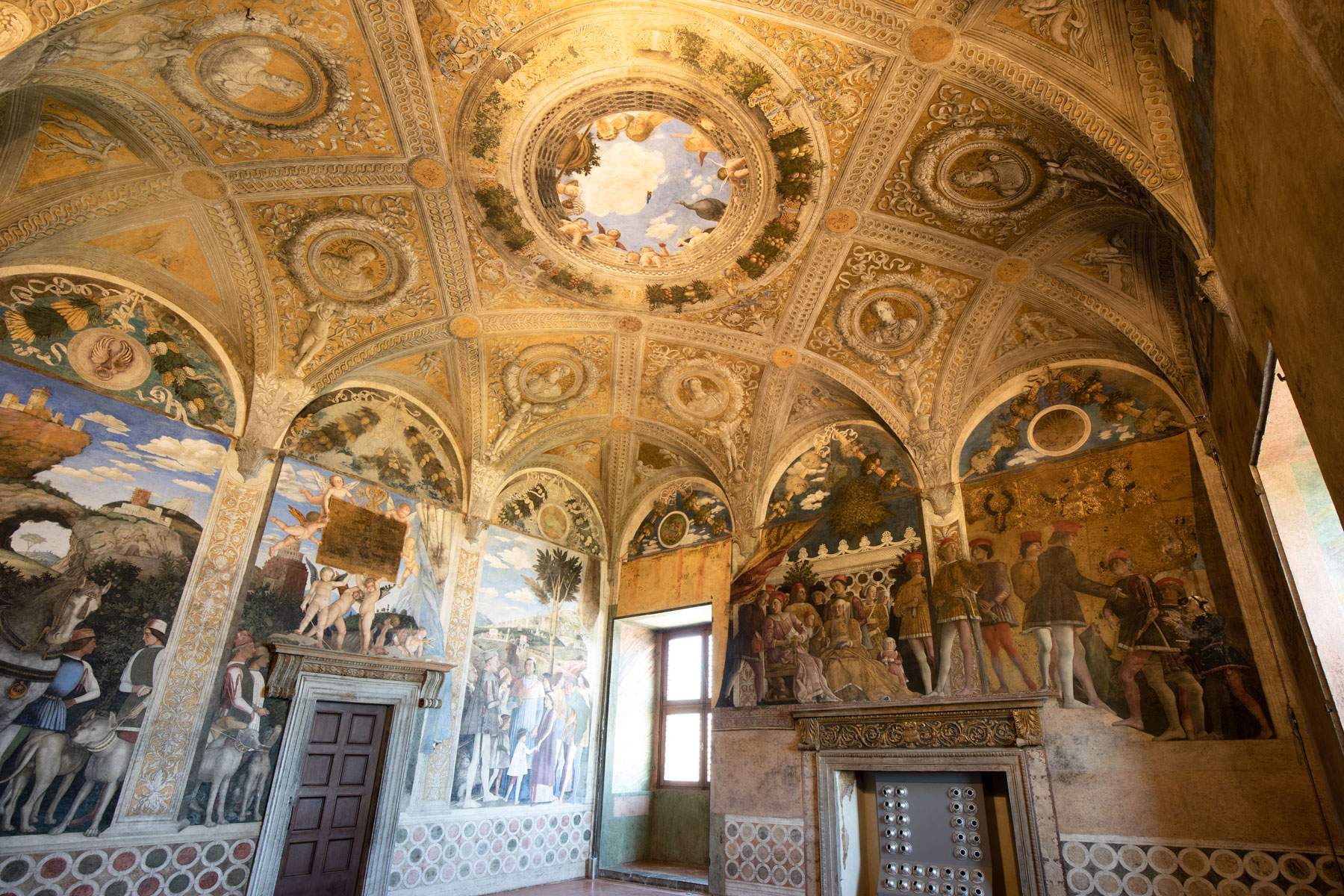 |
| Andrea Mantegna, frescoes of the Bridal Chamber (1465-1474; Mantua, Castle of San Giorgio), view of the room. Ph. Credit Alessandro Pasquali - Danae Project |
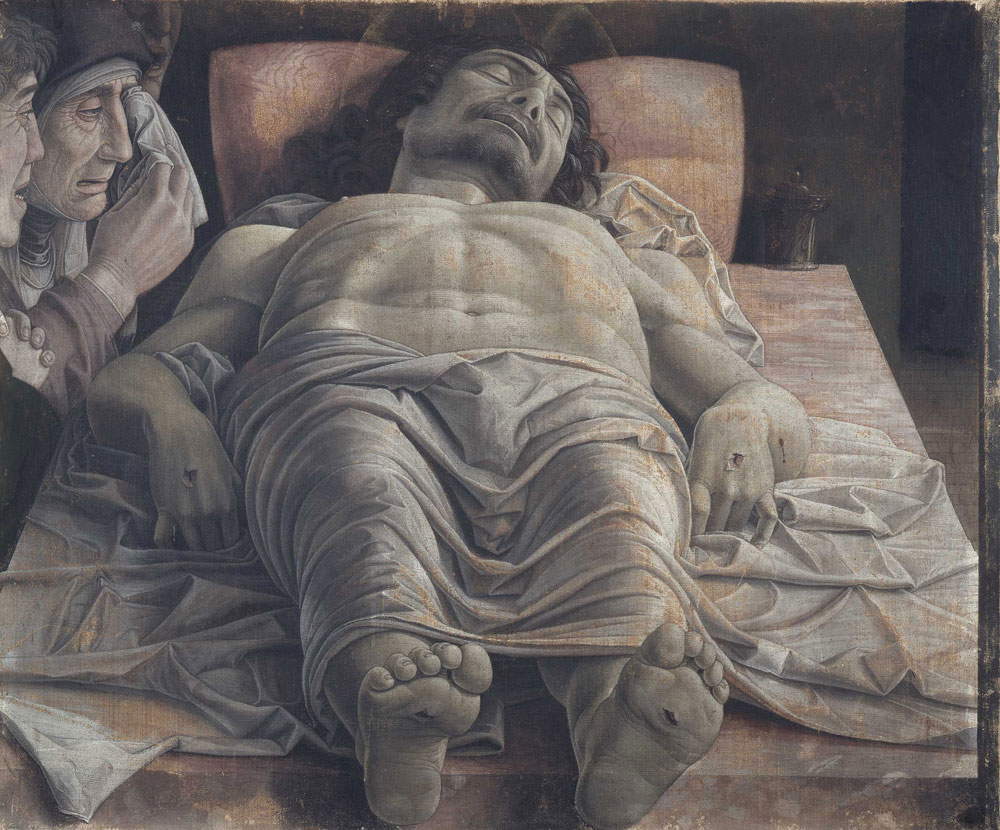 |
| Andrea Mantegna, Dead Christ (c. 1475-1485; tempera on canvas, 68 x 81 cm; Milan, Pinacoteca di Brera) |
It was in the Ovetari Chapel in the Church of the Eremitani that Andrea Mantegna first had an opportunity to express his art completely independently. Due to bombing during World War II, it is only possible to admire in part what must have been the most representative frescoes of the Paduan Renaissance . Here worked together with the Paduan artist other painters such as Giovanni d’Alemagna, Antonio Vivarini and the young Nicolò Pizzolo. Pizzolo was entrusted with the decoration of the oculi within which he depicted the Church Fathers, while Mantegna worked on the Stories of St. James and for a part on the Stories of St. Christopher, to which he devoted himself between 1448 and 1457. On the left side of the chapel are the Stories of St. James in which it is already possible to see an almost archaeological and classical type of interest on the part of the painter. Mantegna very much calibrated the dramatic and expressive aspect of the figures: the tale he narrated with his brush had a more “historical” setting, aimed at restoring the imposing and splendid Roman world. Antique elements were used to reconstruct historical events. The most important innovations in these frescoes were the deep foreshortenings, an element that characterizes the hand of the painter, and the swarming of figures that punctuate the work. In the Stories of St. Christopher (c. 1455), in contrast to the earlier ones, the architecture took on a more illusory appearance and the shapes of the figures became softer. This change of direction was probably due to his encounter with Venetian painters, particularly Giovanni Bellini. When Nicolò Pizzolo died, Mantegna was entrusted with the execution of the apse depicting The Assumption of the Virgin, on which the master worked for a period that is unclear to us, although it is conceivable that the painter worked on it between 1453 and 1457. The small space forced Mantegna to set the fresco vertically divided into two registers: in the other appears the Madonna with angels, while in the lower register the apostles are depicted life-size. The apostles were a source of controversy on the part of the commissioning Empress Ovetari, who brought a lawsuit against him because the painter depicted only eight of the twelve apostles: however, other painters were called in to give an opinion, and they justified Mantegna’s choice because he effectively lacked space.
In Ferrara, Duke Borso d’Este commissioned the Paduan painter, who already painted portraits for Leonello d’Este, to work on theAdoration of the Shepherds, (1499-1450): in the center the Madonna, in adoration of the Child, is flanked by St. Joseph who is leaning against a tree. On the right, on the other hand, two shepherds are depicted kneeling. The colors are brighter as evidenced by the robes of the characters and in some parts of the landscape, and the pathos and expressiveness of the faces is also very pronounced (note the incisiveness of the faces of the two shepherds). Of an entirely different approach is the Polyptych of St. Luke (1453-1455) inside the church of Santa Giustina in Padua, which represented an extraordinary synthesis of Renaissance culture and medieval tradition: rich in cultural references, the work demonstrates the artist’s more erudite and refined side. The polyptych was commissioned by the prior of the monastery of Santa Giustina, Mauro Folperti. The work consists of ten panels: the central one is dedicated to St. Luke, while the others are dedicated to saints venerated by the city of Padua, namely St. Prosdocimo, St. Julian, St. Felicita to St. Justina, whose relics are preserved in the church. The gilded background and cusped forms of the panels testify to the link that Mantegna wanted to maintain with the medieval tradition. Renaissance components, on the other hand, can be seen in the energetic use of color, the effects of light and shadow, and the strong perspective layout. The painter’s change from more rigid forms to shaping the figures in a more harmonious and soft way is evidenced by the San Zeno Altarpiece of 1457-1459(read a more in-depth discussion of the work here), which was commissioned by Gregorio Correr, abbot of the church of San Zeno in Verona. The work is set in an open quadrangular portico bordered by columns. The frame apparently divides the altarpiece into a triptych that is actually united by the wide portico in the background. The original spatial unification was probably inspired by Donatello’s altar in the Basilica of St. Anthony in Padua, which Mantegna had the opportunity to see and study at length. The Virgin sits in the center with the Child, surrounded by Saints Peter, Paul, John the Evangelist, Zeno, Benedict, Lawrence, Gregory the Great, and John the Baptist. The figures are all set in an elegant room decorated with medallions and classical friezes depicting pagan fables, including the Labors of Hercules. The black and white checkerboard floor also contributes to the room’s depth and spatiality. The festoons in the foreground highlight the scene, and touches of red represent the passion of Christ. The predella at the bottom depicts three scenes: theOration in the Garden, the Crucifixion, and the Resurrection of Christ. The three representations are all in France following spoliation by Napoleon in 1797. The altarpiece marks the new model of Sacra Conversazione in which the central part is unified; moreover, it was the first Renaissance altarpiece in northern Italy. Mantegna’s classical taste was well expressed by Saint Sebastian (1480-1481): the martyr is standing with his arms tied behind his back and his body is pierced by arrows. A landscape opens in the background, while immediately behind Saint Sebastian appears a column with a Corinthian capital to which the martyr is tied. In the lower left corner the foot of an ancient statue can be seen, and on the opposite side the two torturers are painted, one of them still holding the arrows. The figure of the martyr was probably a pretext for depicting a classically inspired nude: in fact, the man is reminiscent of ancient Greek statues. Two other versions of the Martyrdom of Saint Sebastian exist, one preserved in Vienna and the other in Ca’ d’Oro in Venice. Mantegna devoted himself not only to painting but also practiced the technique of the burin: the Bacchanali series(Bacchanali with Silenus and Bacchanali with a Vat) is one of the works attributed to Mantegna, although the dating is uncertain. In both woodcuts (engraved on copper with burin) the painter describes moments of happy abandonment to vices and presents a world dominated by instincts.
Following his move to Mantua, Ludovico III Gonzaga entrusted the Paduan painter with the decoration of the chapel in the castle of San Giorgio and which today has become a wing of the Ducal Palace in Mantua. The chapel’s pictorial decoration included an altarpiece depicting the Death of the Virgin (1462), now in the Prado Museum in Madrid. The scene takes place inside a room; in the background is depicted the Virgin wrapped in a monk’s habit. Around her are depicted the eleven apostles. Above the main scene is a large window from which one can see a landscape depicting Lake Mincio and the bridge of San Giorgio, which were actually visible from the windows of the castle. The setting is described by a dizzying perspective also accentuated by the checkerboard floor. The whole composition is enveloped in a halo of great naturalness that the painter did not abandon even in later works. Between 1460 and 1464, the Uffizi Triptych was created, or three wooden panels depicting The Ascension, The Adoration of the Magi and The Circumcision. The consistency of the subjects chosen by the painter was probably part of a single project. The Ascension is perhaps the most mystical panel and is divided into two parts: in the upper Christ, resting on a new one, ascends making the gesture of blessing, while in the lower part the Virgin and the apostles are shown circling around the tomb looking upward. In the ’Adoration of the Magi, the procession of figures, in an undulating motion given by the road in the distance, moves toward the cave of the Nativity, in which the Virgin and Child are standing. Above we see four angels praying, while the ox and the donkey stand aside. Finally, the Circumcision: the scene takes place in a room with a classical interior, and refined decorations. Behind the scene the old-fashioned decorations show extraordinary archaeological sensitivity. In the center, a large marble column holds a capital inspired by the Corinthian order from which two round arches are cast. Below the arches, two lunettes contain depictions of the Sacrifice of Isaac and the Delivery of the Tables of the Law. The space between the two arches is instead occupied by a cherub. The panel is one of the finest works of the artist, who succeeded in declining the various classical elements according to a personal and highly original taste.
Andrea Mantegna again returned to the Castle of San Giorgio, this time to decorate a reception room: this is the Bridal Chamber, one of the highest and most refined results of the painter’s artistic research. Work on the room began around 1465 and was finished in 1474: both dates can be read in the fresco(read a detailed discussion of the Bridal Chamber here). The decoration had as its objective the celebration of the Gonzaga family, in fact in the pictorial cycles there are references to the political and religious dynasty and to the recognition of the title of marquisate, obtained by the Gonzagas in 1432, so the fresco is nothing but a strong political allegory. The frescoes were modulated by Mantegna by paying some attention to the architectural layout of the room: the square room is covered by a vault. Decorated pilasters on the walls mark the limits of a space that the artist opens, illusorily, beyond the actual walls. Even real architectural elements are controlled by the painter by creating a visual deception to the observer in front, as in the case of the protruding door frame that has become a kind of podium on which putti are depicted; see also the lintel of the fireplace, transformed into the landing of the staircase. On the ceiling, the ribbed vault was made in perspective with the intention of simulating cubic proportions, and in the center of the vault is the famous oculus, one of the most successful examples of views from below. On the north wall was portrayed Ludovico Gonzaga with his court at the moment when he is about to receive the news of his son Francesco’s election to the cardinal’s throne; on the west wall was depicted the meeting between the marquis and his son Cardinal Francesco; in the background, on the other hand, we see the city of Rome where we recognize the Colosseum, the Theater of Marcellus and the Aurelian Walls. It is interesting to note how the portraits of the scenes on the walls connect with the medallions in the vault depicting Roman emperors: the political and dynastic message is very strong and clear, the Gonzagas stand alongside famous examples of power and family dynasty, and Mantegna succeeded in visually writing the political message in an extraordinary and innovative way.
The famous Dead Christ of uncertain date(read a detailed discussion of the masterpiece here) was made by the painter for his own private devotion, and was in fact found in his home in Mantua after his death. The scene depicts the body of the dead Christ, lying and half-covered by a sheet, on a stone slab that exudes all its coldness. Next to it, on the left side appear the mourning women. The whole scene, however, is obscured by the strong perspective scrounge, similar to the oculus in the Bridal Chamber, which here becomes the real protagonist. Mantegna’s last works include the famous Triumphs of Caesar (1484-96) where the artist synthesized antiquarian reconstruction, medieval tradition, and his very personal interpretation. The ambitious project consisted of nine monumental canvases that recreated the triumphal painting of Ancient Rome and were commissioned by Francesco II Gonzaga to emphasize his new title of “Novo Cesare.” The artist used a number of literary sources to design the canvases. Fascinating to note is the artist’s classical sensibility evidenced by the composition of the works that re-propose the typology of “Roman triumphal painting.” The entire procession takes place outdoors and the figures are slightly lower than the viewer. The success of this work was enormous, there were no guests who did not admire it, and all agreed on its beauty and extraordinariness. Francesco Gonzaga married Isabella d’Este in 1490, considered by many to be one of the most beautiful and cultured women of the Renaissance. The young Isabella devoted herself to culture and art so she commissioned Mantegna to paint several works of art with mythological themes for the purpose of decorating the woman’s studiolo in the castle of San Giorgio. In 1497 the painter produced the Parnassus and in 1502 the Triumph of Virtue. In the first panel a group of girls dance in the presence of Venus and Mars surrounded by numerous classical deities. The less rigid figures here take on a more casual and natural appearance perfectly set in the landscape, probably the result of the influence of his brother-in-law Giovanni Bellini. The second panel represents the allegory of Virtue, its triumph over the human soul after Vice has been driven out. The iconographic program is very complex, so it is most likely that Isabella’s advisor and poet Paride da Ceresara guided the artist’s hand. Andrea Mantegna, in short, was an artist characterized by a strong capacity for innovation, among the most appreciated of his time. His curiosity and desire for knowledge led him to be one of the greatest painters of Renaissance art.
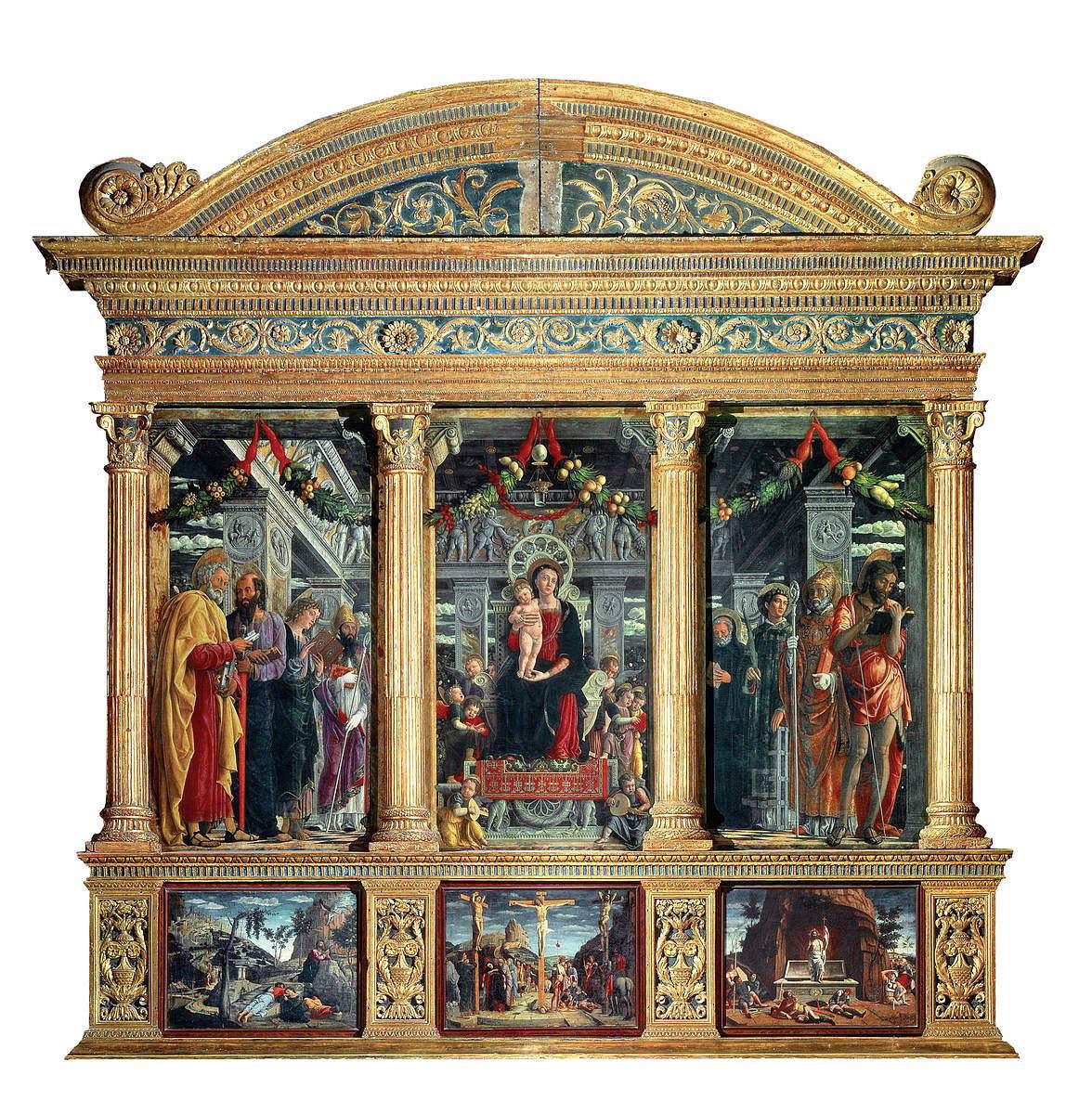 |
| Andrea Mantegna, San Zeno Altarpiece (1457-1459; Verona, San Zeno) |
 |
| Andrea Mantegna, Trivulzio Altarpiece (1497; tempera on canvas, 287 x 214 cm; Milan, Pinacoteca del Castello Sforzesco) |
 |
| Andrea Mantegna, Saint Sebastian (c. 1475; tempera on canvas, 257 x 142 cm; Paris, Louvre) |
In Padua at the Church of the Eremitani it is possible to see only part of the pictorial fresco cycle of the Ovetari Chapel and theAssumption of the Virgin . In Mantua at the Ducal Palace it is possible to see the Bridal Chamber but also the Holy Family and Family of the Baptist, at the Church of Sant’Andrea in the Mantegna Chapel. The Pinacoteca di Brera in Milan houses the Dead Christ, and the Polyptych of St. Luke . Also in Milan, the beautiful Pala Trivulzio can be admired in the Pinacoteca del Castello Sforzesco. In Verona, the Renaissance Pala di San Zeno is preserved in the Basilica of San Zeno; the panels that made up the predella, on the other hand, are kept in France: theOration in the Garden and the Resurrection of Christ are in the Musée des Beaux-arts, while the Crucifixion belongs to the Musée du Louvre. At the Uffizi Galleries in Florence are the Uffizi Triptych, Portrait of Charles de’ Medici, and the extraordinary Madonna delle Cave. The works Introduction of the Cult of Cybele in Rome, Holy Family with St. John, Samson and Delilah, and many other important works are at the National Gallery in London. The Triumphs of Caesar are all preserved in their monumentality at Hampton Court in London.
 |
| Andrea Mantegna, life and works of the master of the Mantuan Renaissance |
Warning: the translation into English of the original Italian article was created using automatic tools. We undertake to review all articles, but we do not guarantee the total absence of inaccuracies in the translation due to the program. You can find the original by clicking on the ITA button. If you find any mistake,please contact us.